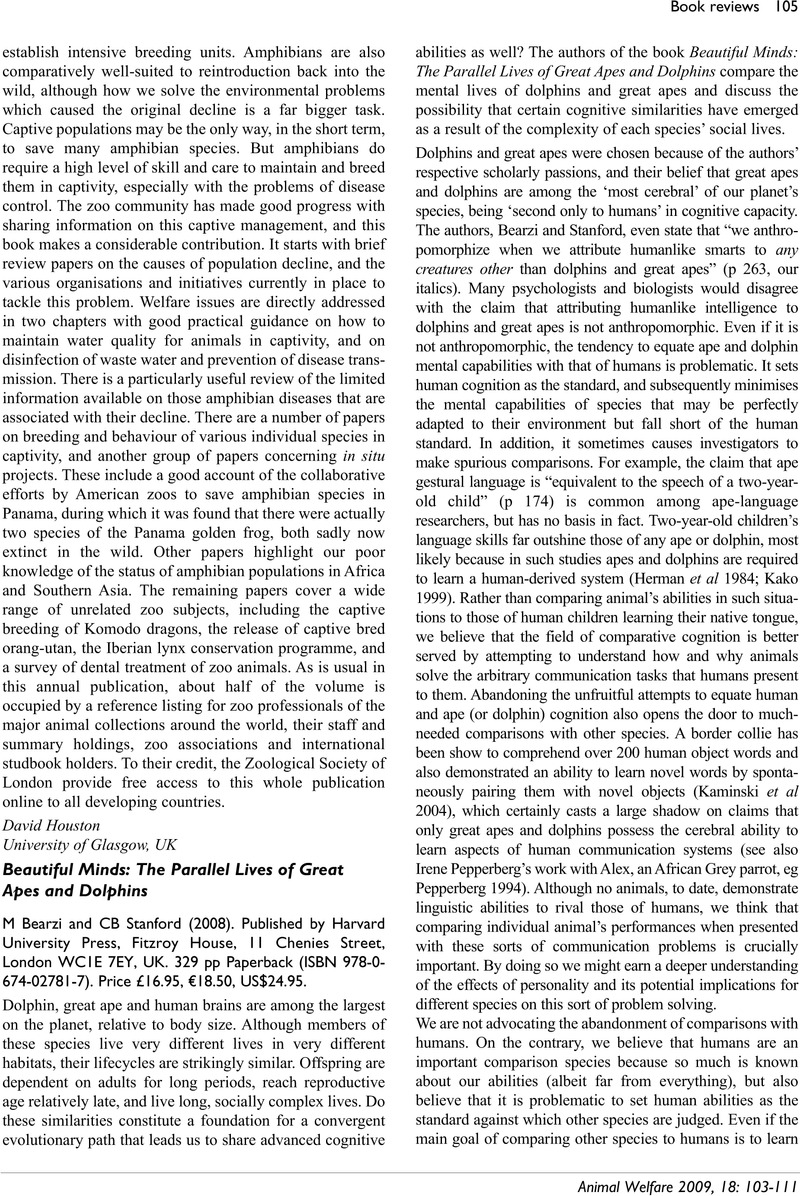No CrossRef data available.
Article contents
Beautiful Minds: The Parallel Lives of Great Apes and Dolphins M Bearzi and CB Stanford (2008). Published by Harvard University Press, Fitzroy House, 11 Chenies Street, London WC1E 7EY, UK. 329 pp Paperback (ISBN 978-0674-02781-7). Price £16.95, €18.50, US$24.95.
Review products
Beautiful Minds: The Parallel Lives of Great Apes and Dolphins M Bearzi and CB Stanford (2008). Published by Harvard University Press, Fitzroy House, 11 Chenies Street, London WC1E 7EY, UK. 329 pp Paperback (ISBN 978-0674-02781-7). Price £16.95, €18.50, US$24.95.
Published online by Cambridge University Press: 01 January 2023
Abstract
An abstract is not available for this content so a preview has been provided. As you have access to this content, a full PDF is available via the ‘Save PDF’ action button.

- Type
- Book Reviews
- Information
- Copyright
- © 2009 Universities Federation for Animal Welfare
References
Amundin, M, Starkhammar, J, Evander, M, Almqvist, M, Lindstrom, K and Persson, HW 2008 An echolocation visualization and interface system for dolphin research. Journal of the Acoustical Society of America 123(2): 1188–1194CrossRefGoogle ScholarPubMed
Gold, KC and Maple, TL 1994 Personality assessment in the gorilla and its utility as a management tool. Zoo Biology 13: 509–522CrossRefGoogle Scholar
Gosling, SD and John, OP 1999 Personality dimensions in nonhuman species: A cross-species review. Current Directions in Psychological Science 8: 69–75CrossRefGoogle Scholar
Herman, LM, Richards, DG and Wolz, JP 1984 Comprehension of sentences by bottlenosed dolphins. Cognition 16: 129–219CrossRefGoogle ScholarPubMed
Highfill, L and Kuczaj, S 2007 Do bottlenose dolphins (Tursiops truncatus) have distinct and stable personalities? Aquatic Mammals 33: 380–389CrossRefGoogle Scholar
Kako, E 1999 Elements of syntax in the systems of three language-trained animals. Animal Learning and Behavior 27(1): 1–14CrossRefGoogle Scholar
Kaminski, J, Call, J and Fischer, J 2004 Word learning in a domestic dog: evidence for “fast mapping”. Science 304: 1682–1683CrossRefGoogle Scholar
Kuczaj, SA, Makecha, RN, Trone, M, Paulos, RD and Ramos, JA 2006 The role of peers in cultural transmission and cultural innovation: Evidence from dolphin calves. International Journal of Comparative Psychology 19: 223–240Google Scholar
Kuczaj, SA and Walker, R 2006 Problem solving in dolphins. In: Zentall, T and Wasserman, E (eds) Comparative Cognition: Experimental Explorations of Animal Intelligence pp 580–601. MIT Press: Cambridge, MA, USAGoogle Scholar
Kuczaj, SA and Yeater, D 2006 Dolphin imitation: Who, what, when and why? Aquatic Mammals 32: 413–422CrossRefGoogle Scholar
Kuczaj, S and Makecha, R The role of play in the evolution and ontogeny of contextually flexible communication. In: Griebel, U and Oller, K (eds) The Role of Contextual Flexibility in the Evolution of Communication. MIT Press: Cambridge, MA, USA, in pressGoogle Scholar
Pepperberg, I 1994 Vocal learning in Grey Parrots (Psittacus erithacus): effects of social interaction, reference, and context. Auk 111: 300–313CrossRefGoogle Scholar
Poirier, FE and Fitton, LJ 2001 Primate cultural worlds: Monkeys, apes, and humans. Behavioral and Brain Sciences 24: 349–350CrossRefGoogle Scholar
Starkhammar, J, Amundin, M, Olsén, H, Dahl, S, Almqvist, M, Lindström, K and Persson, HW 2007 Design and evaluation of a new tool for echolocation measurements, Abstract for 17th Biennial Conference on the Biology of Marine Mammals. Cape Town, South Africa.Google Scholar


